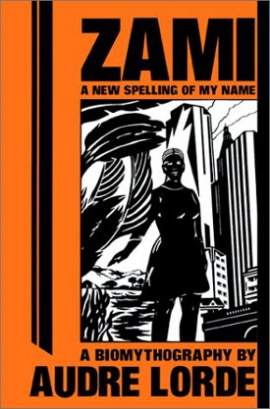This content is being reviewed in light of recent changes to federal guidance.
Biomythography in the Life Narrative and the Poems of Audre Lorde
 This semester, I am enrolled in Dr. Maryemma Graham’s “Life Writing: Contemporary Autobiography—Theory and Practice Course”. Many of the texts we have read this semester interestingly complicate the concepts of autobiography and memoir. For example, Audre Lorde refers to her life narrative as a biomythography. In “Self-Representation: Instabilities in Gender, Genre, and Identity,” Leigh Gilmore writes, “…self/life/writing—is exchanged for the terrain of biomythography” (27) in Zami. That is, the text represents a space in which “homes, identities, and names have mythic qualities” (27). Examining her text closely, one can claim that biomythography is a combination of myth, history, and biography.
This semester, I am enrolled in Dr. Maryemma Graham’s “Life Writing: Contemporary Autobiography—Theory and Practice Course”. Many of the texts we have read this semester interestingly complicate the concepts of autobiography and memoir. For example, Audre Lorde refers to her life narrative as a biomythography. In “Self-Representation: Instabilities in Gender, Genre, and Identity,” Leigh Gilmore writes, “…self/life/writing—is exchanged for the terrain of biomythography” (27) in Zami. That is, the text represents a space in which “homes, identities, and names have mythic qualities” (27). Examining her text closely, one can claim that biomythography is a combination of myth, history, and biography.
Furthermore, the narrative and rhetorical strategies that Lorde employs throughout Zami help to present a mythic quality to her actual lived experiences. For example, when she recalls a childhood experience, she writes,
My lifelong dream of a
doll-baby come to life had in fact come true. Here she stood before me now, smiling
and pretty in an unbelievable wine-red velvet coat with a wide, wide skirt that
flared out over dainty little lisle-stocking legs. Her feet were clad in a pair
of totally impractical, black patent—leather mary-jane shoes, whose silver
buckles glinted merrily in the drab noon light.
(37)
Words, such as “dream” and “unbelievable” paired with the intensity of the details that she provides about the girl’s outfit reinforce the narrative as a biomythography. Some may argue that though real, meeting the girl was also a mythic experience for Lorde. Some readers may also argue that Lorde views the little girl as a myth, that though she existed, her unbelievable qualities paired with Lorde’s dream of having a life doll make her a mystic being.
Moreover, though Lorde seems to apply the term to her entire text, I find that biomythography is most present in the original poems that she includes in her narrative. The poems present a mystic self as they tell the story of a “true” encounter. The poems written about her herself and romantics relationships in particular seem to present a fantastical person and experience. For example, the text reads,
I was the story of a phantom people
I was the hope of lives never lived
I was a thought-product of the emptiness of space
and the space in the empty break baskets
I was he hand, reaching toward the sun
the burn crisp that sought relief… (18)
Here, “hope,” “phantom,” “empty” and the phrase, “hope of lives never lived” display the ways in which she mythologizes herself in the text, and continues to develop her biomythography. Furthermore, myth seems to an important quality not only to Lorde’s life narrative, it seems to be a significant element of poetry outside of Zami as well:
Love Poem
Speak earth and bless me with what is richest
make sky flow honey out of my hips
rigis mountains
spread over a valley
carved out by the mouth of rain.
And I knew when I entered her I was
high wind in her forests hollow
fingers whispering sound
honey flowed
from the split cup
impaled on a lance of tongues
on the tips of her breasts on her navel
and my breath
howling into her entrances
through lungs of pain.
Greedy as herring-gulls
or a child
I swing out
over the earth over and over
again.
The speaker may or may not be Lorde and this poem is not included in Zami; there remains a mystic quality to the “I”. One could argue, then, that in writing a poem that occupies some sort of autobiographical space, Lorde continues to present biomythography across multiple texts. Throughout these autobiographical and/or “I” texts, she recalls personal history (biography) as she recreates the self as a myth, especially through relationships/interactions with others.